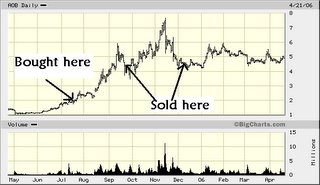 The other day I talked about portfolio outperformance, suggesting one method to outperform the broader market. This method, a "focused portfolio", has plenty of academic support for its effectiveness and rationale. Yet, it doesn't suit every investor. It's time intensive and requires at least average investing skills (i.e. the ability to read a balance sheet, earnings and cash-flow statements). So it's definitely not for everyone.
The other day I talked about portfolio outperformance, suggesting one method to outperform the broader market. This method, a "focused portfolio", has plenty of academic support for its effectiveness and rationale. Yet, it doesn't suit every investor. It's time intensive and requires at least average investing skills (i.e. the ability to read a balance sheet, earnings and cash-flow statements). So it's definitely not for everyone.But the great thing about investing is that there is more than one way to "skin a cat", as the saying goes. That means you can outperform the broader market (which I define as the S&P 500), by doing other things well. One way is through asset allocation and the use of low-cost ETFs to build a portfolio.
A way to enhance these returns is by investing with history on your side - in other words, finding the type of investments that have historically produced above average returns. Of course, also investing with an eye to what the world might be like in ten to twenty years, is another way to boost your returns.
So, having said that, what are some practical ways to build a low-maintenance outperforming stock-market based ETF portfolio for the next ten to twenty years?
Firstly, to acknowledge that so-called "value" stocks and "value indices" produce better market returns - on average - than so called "growth" stocks and "growth indices".
Secondly, to consider that small company stocks traditionally produce better returns than large company stocks.
Thirdly, to see the rapid rise of the emerging markets, and to acknowledge they are likely to be far larger in twenty years than today (they are producing about 20% of global goods today, yet their stock markets only hold about 5% of the capitalized value of stocks in the global economy).
Fourthly, that these advantages should also be stabilized with some large company stocks and broad-based market exposure, that will produce relatively reliable returns over a longer period.
Fifthly, to consider that the US trade and fiscal deficits are likely to continue impairing the currency for a while longer, and therefore willingly have greater than average exposure to other markets.
Finally, to consider your particular own thoughts and ideas, and to add these into the mix somewhat. This might be the idea that health-care stocks will prosper into the future, or perhaps that technology stocks now appear reasonably priced, or that commodities appear to have a bright future for the next five to ten years. Whatever - the point is is to add one or two of those themes into your overall investing mix, if you feel comfortable doing that.
Now, here is a sample portfolio I've constructed that I think would be suitable for an investor with a twenty year horizon (this is the all-stock market portion of the portfolio), and with a willingness to overload promising positions, as discussed recently. For the twenty year investor, this is the type of portfolio that probably needs only to be re-visited and re-balanced every five years or so. So remembering our themes of:
- Value orientation;
- Small companies orientation;
- Emerging Markets exposure;
- Some Broad-based;
- Consideration of currency implications (ie more exposure to international);
- Your own ideas (in this case, mine);
- 20% Broad-based international - EFV - $64.91 - ishares product tracks the MSCI EAFE Value Index, which tracks European, Australian, and Far Eastern markets. This index has outperformed the broader (non-value) index MSCI EAFE index by about 2% annually over the past five year. Five year return on the index is 11.7% annually.
- 20% Small company - IWN - $74.99 - ishares product tracks the Russell 2000 Value Index (US small cap). It has outperformed the broader (non-value) Russell 2000 Index by about 3.4% annually over the past five years. Five year return on the index is 16.2% annually.
- 25% Emerging markets - EEM - $105.45 - a broadly-based (for emerging markets) ishares product tracks the MSCI Emerging Markets Index. Five year return on the index is 23.2% annually.
- 20% S&P 500 - IVE - $70.62 - an ishares product tracking the value portion of the S&P500. Produced a 5.0% annual return over the past five years, beating the broader based S&P500 by 1.0% annually.
- 15% Own Ideas (in this case, my belief that commodity-oriented countries will do well for the next five to ten years). I'd equally weight a Canadian ETF (EWC) - $24.86 - and a Brazilian ETF (EWZ) - $44.25 - or Australian ETF (EWA) - $21.94. Five year returns on these indices have ranged from a low of 18.2% to 27.9% annually.
Of course, you can always tinker with this, but this is a simple, pretty well-balanced stock portfolio, constructed with the aforementioned moderately overweighting themes in mind. I personally would sleep very easy with this portfolio. We'll check back in with this model portfolio in six months to a year.

JW
The Confused Capitalist
Support this blog and our advertisers: check out the advertised listings.




















